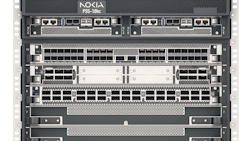Nokia Expands 1830 PSS Family with High-Capacity Shelves for Scalable Optical Networks
Meeting Surging Bandwidth Needs
Nokia has introduced its carrier-grade 1830 Photonic Service Switch-High Capacity (PSS-HC) shelves in a recent press release, growing its 1830 PSS family with this next-generation addition. Nokia’s shelves deliver up to three times higher density while reducing power consumption per bit by up to 60%. This provides service providers with the opportunity to scale their networks cost-effectively and efficiently.
Nokia’s Shelves Integrate into Existing Deployments
The PSS-HC shelves, including the PSS-10hc and PSS-4hc, are designed to integrate seamlessly into existing 1830 PSS networks. They support high-density deployment of the latest embedded and coherent optical engines, providing up to 12Tb/s per slot. The shelves' front-to-back airflow and advanced power management features additionally support these deployments.
Supporting Cloud, AI, and Mobile Services
The high-capacity shelves enable operators to meet growing demand for cloud, AI, video, enterprise, and mobile services. Vivek Gaur, VP Engineering at Colt Technology Services, said, “Nokia’s 1830 PSS-HC shelf builds on the current 1830 family of products used in our network. We anticipate the new enhancements to address our increasing capacity demands by utilizing advanced optical engines while retaining the existing operational framework.”
Carrier-Grade Performance for Rapid Deployment
Ron Johnson, Senior VP and GM of Optical Networks at Nokia, added, “In the era of AI, operators need to scale bandwidth faster and more cost-effectively than ever. The 1830 PSS-HC shelves represent an important evolution of the 1830 PSS family, combining ultra-high density with greater capacity and the PSS rich set of carrier-grade features. With this evolution, operators can rapidly deploy high-speed services to keep pace with growing customer demand.”
Availability
The Nokia 1830 PSS-HC shelves are scheduled for commercial availability in Q2 2026, with customer trials beginning in late 2025.
